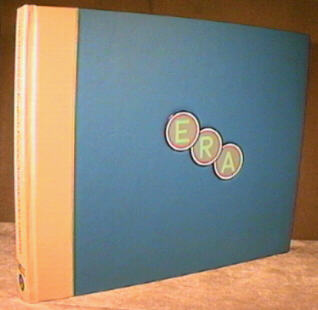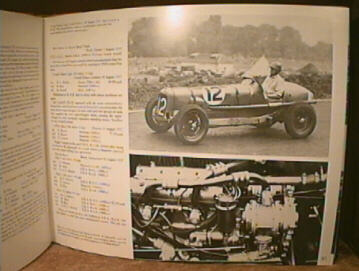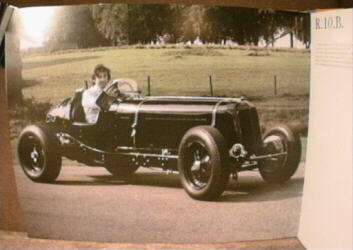INTRODUCTION
`Charisma' is a Greek word meaning `a
gift', and `charism' was a power to perform miracles
conferred on the early Christians. A ' few people have
charisma, and so do a few machines. Two British examples
of the latter having it in abundance are the Spitfire
aeroplane and the E.R.A. racing car, both evolved in the
nineteen-thirties. Neither was overwhelmingly better than
its contemporaries, but both were products of enthusiasm
and private enterprise and both seem to have had a power
conferred upon them to achieve an eminence in future
years which can hardly have been anticipated by their
originators. Indeed, anyone who admits to having driven
an E.R.A. or flown a Spitfire is certain to invite a
wholesale breaking of the tenth commandment by less '
fortunate mortals who have not had the experience. It is
tribute enough to the E.R.A. that nearly fifty years
after its birth David Weguelin, who is too young to ever
have seen E.R.A.s performing in their heyday, has had the
incentive to go to , immense trouble to compile this
detailed history of the marque and has found publishers
with the enthusiasm to launch his work ' in the form of
this beautifully produced and lavishly illustrated book.
In these days when an average family saloon can
outperform ' many a vintage racing car (though not all of
them, I am glad to say!), it might be thought that
driving an E.R.A., which is only slightly newer, yet
still very nearly fifty years old, cannot be so very
thrilling. This is not so for several reasons, one being
that even by modern standards an E.R.A. is fast, being
capable of at ... least 125 mph (some nearer 150mph) with
acceleration to match, ' but the suspension is hard and
the roadholding on the primitive side. Perhaps the latter
factor is not so significant on modern circuits because,
paradoxically, as racing car suspension improves '. so
surfaces are getting smoother and the circuits are made
to suit the cars with great precautions taken not to
upset them and their drivers in both senses of the word.
Today there are very few `natural' circuits left. It is
some twenty years since I myself first drove an E.R.A.,
the 2 litre RllB, one of the faster examples of the
marque, and perhaps what I wrote about the experience at
the time in a book now long out of print called `Racing
an Historic Car' may be of interest. It happened on the
Silverstone Grand Prix circuit.
`I went slowly round Woodcote, and then opened the
throttle and felt I ,was being hurled forward by a
typhoon. Of course one gets used to anything, so it is
one's first few laps in a racing car one should try to
remember. Everybody has experienced that feeling in a
low-powered car
of putting one's foot hard down in the throttle, and
waiting for something to happen.
In the E.R.A. it always happened before I was ready for
it and, at first, accelerating away
from a corner was like being on a runaway horse, I was
not really sure I wanted to be getting away from the
corner at such a rate of knots. Rounding Chapel Curve, I
felt myself experiencing what seemed to me excessive
"g" for the first time in a car, through being
pushed hard back in the seat when accelerating, and
pre-selecting the gears going down Hangar Straight was
difficult for two reasons; firstly, putting one's hand
out to grab the lever was like putting it into the
slipstream of a Tiger Moth, and secondly it was so bumpy
that it was difficult to get hold of the lever anyway. It
was all so completely fascinating that it was hard to
persuade oneself to stop. Not once on that particular day
did I have the throttle hard on the floor and hold it
there, and so far as the wide open spaces of airfield
circuits are concerned, to me it seemed an endless
succession of corners, except for Hangar Straight, which
was the only place I got into top gear. I found the
pre-selector box took a little getting used to as instead
of changing gear in one complete movement it is actually
two separate ones.' Raymond Mays was a pioneer in several
aspects of motor racing which are accepted as normal
today, and E.R.A. was the first small British firm
specialising in the exclusive manufacture and sale of
racing ears. Geoffrey Taylor, of Alta, came in much the
same category, but he started by making a sports car and
was also a sports car manufacturer, though on a very
small scale. To him must go the credit for designing and
building his own engines, though they were less
successful than the Riley based E.R.A. engines in the
pre-war days. A Connaught fitted with an Alta engine won
the 1955 Syracuse G.P. with Tony Brooks at the wheel, for
few of the British specialist racing car constructors of
later years designed and built their own engines, B.R.M.
and Vanwall being exceptions. Mays must also have been a
pioneer of sponsorship, seeking backers for his racing so
that he could continue competing, his sponsors being
connected with the motor accessory trade, yet he himself
was a great advocate of the ethos of amateurism in sport.
On his own admission, he certainly did not enjoy trying
to talk to people into backing him.Today in every sport,
including motor racing, a single minded dedication to
succeed is the norm, and everybody seems to have the will
to win in super abundance, a stimulus, no doubt, being
the big financial rewards involved. Mays had this will to
win, partly because it was a natural part of his make-up,
but also because when he had backers he had a fear of
letting other people down. Mays, like the E.R.A.s, had
charisma as did two other young men who brought a great
deal of glamour to motor racing and to E.R.A. before the
war, the Siamese royal princes Prince Birabongse
Bhanubandh and his cousin Prince Chula Chak- Rabongse,
the former doing the driving and the latter the managing
all on an amateur basis. However, one has only to read
Prince Chula's books about their racing experiences to
realise the will to win was tremendous and his
organisation was, in fact extremely professional. Less
professional conduct, perhaps, took place on the occasion
when Bira drove his newly acquired E.R.A. `Romulus' from
its garage in Dieppe out to the circuit early one July
morning to practise for the 1935 Dieppe G.P., his first
race in the car, only to lose his way and drive round and
round the town looking for the right road! To make up for
this, though, he did finish second in the race,
convincing proof that he eventually found where the
circuit was. The driving of the E.R.A.s on public roads
is always a fascinating subject, whether within or
without the law, and several instances of it are given in
this book. The best known recorded cases in this country
are the excursions by the works cars for testing purposes
on a circuit near Bourne, and Mays's drives in 2 litre
cars to Shelsley Walsh for the autumn, 1934, meeting and
to the docks at Harwich for shipment to the continent for
the 1935 German G.P., both from the works at Bourne. The
longer journeys were evidently legal by courtesy of
`small wings, a hooter and a large fishtail', the testing
sessions on the deserted fen roads less so. In recent
years when Peter Waller owned R.9.B. he discovered that
the famous former racing driver Denis Poore was a
neighbour of his in the country, and obviously the only
suitable transport which to pay him a visit was the
E.R.A. Unfortunately ever time he arrived at the Poore
residence the owner was out, and the gardener could not
make out who this eccentric man was who kept turning up
in this very noisy car with only one seat in it asking
for Mr. Poore. On another occasion a Vintage Sports Car
Club member, who had better be nameless, had been working
on his E.R.A., which still had its racing numbers on it
from the last event it ran in, and he could not resist
taking it `round the block' a couple of times for a test
in a semi-rural area. Unfortunately he disturbed an old
lady who rang the police to complain that a red racing
car had passed her house twice making a terrible and
obviously illegal noise. Did you get its number?' asked
the policeman. `Yes,' said the old lady,`it was no. 7.'
And, on the subject of noise, surely to the enthusiast
the sound of a well tuned E.R.A. is one of the most
thrilling sounds in the world, unparalleled for me even
by that deep rumble of the Monoposto Alfa Romeo (the
`P3') or the calico tearing sound of a Bugatti,
marvellous though the latter are. I was thirteen years
old when the first E.R.A. was made, at that time a motor
racing enthusiast of some five years' standing, and made
every effort to attend race meetings, whether it was by
bicycle to the Crystal Palace, by car to Donington Park
with members of my family, by car or train (if I was on
my own) to Brooklands, it being possible to buy a
combined rail and Brooklands entrance ticket from
Waterloo to Weybridge. In those days I could distinguish
a11 the drivers of E.R.A.s, partly by the racing clothing
they wore, but mainly by their attitude at the wheel, for
it was all very highly personalised, unlike today when
modern racing car drivers are hidden in their cockpits,
and thus are virtually indistinguishable from each other.
My actual contacts with racing drivers were few and
rather ephemeral. I once pushed Teddy Rayson's Maserati
with several other volunteers in response to his cheerful
exhortations in the paddock at Brooklands, and Michael
May, a leading amateur Alvis driver who gets a mention in
this book, actually saluted me once. This was when,
having just passed my driving test, I was at the wheel of
my father's 192712/50 Alvis saloon following the veterans
on the Brighton Run, and M. W. B. May approached from the
opposite direction driving another vintage Alvis. Despite
a fairly long service career which followed, this was
easily the most memorable exchange of salutes I ever
experienced. It must have been in 1943 that I went to a
party in Newcastle-upon-Tyne as a newly qualified R.A.F.
Sergeant-Pilot which resulted from meeting some complete
strangers in a pub, the hospitality being tremendous in
that part of the world. During the evening a friend of
mine who was also invited said `Do you know there is an
E.R.A. driver here?', and before long I was speaking to
ari Army Captain called Dennis Scribbans, who I had
watched win his first race, the final of the British
Mountain Championship, in his newly acquired cream
coloured E.R.A. R.9.B. at Brook-lands at Easter, 1936.
This was the last race of the day and when it was over i
well remember it became cold and rather misty, and the
slight sense of depression this brought with it almost,
but not quite, overcame the magic of being at Brooklands.
My memory of Dennis Scribbans is now rather hazy, but I
do remember being impressed by the fact that he arrived
at the party on a motor cycle and sidecar combination
which he parked in the front garden. Reverting to Teddy
Rayson again, in the nineteen-sixties I became a flying
instructor at Cambridge University Air Squadron, and on
the board in the hall of the Squadron headquarters in
Chaucer Road bearing the names of C.U.A.S. members who
had been killed in the R.A.F. in the second world war was
inscribed the name `E. K. Rayson'. Like thousands of
others I had a desire to race an E.R.A., but the snag
with motor racing is that cars change over the years, and
thus so does the sport, unlike football or cricket which
are always much the same as the participants only bow to
the march of progress by wearing shorter shorts in the
one case and harder hats in the other; but a small boy
who wished to emulate Bob Gerard in his E.R.A. in 1948,
would find to his bitter
disappointment that by the time he was old enough to be
able to afford to race all the single-seaters had the
engines at the wrong end, superchargers were
unfashionable, and there were no courses on which he
could race over tramlines and past pillar boxes.
Fortunately the Vintage Sports Car Club has come to the
rescue of all such people suffering from arrested
development, and although the V.S.C.C. organisers cannot
now use circuits with the aforementioned natural hazards,
at least they have continued to put on races for
out-of-fashion cars like E.R.A.s, thus serving to keep
them very much in fashion. As this book shows, the
majority of pre-war E.R.A. drivers were amateurs, many of
them `garagistes' of one sort or another, but others had
quite different occupations, Bira had his sculpting and
Billy Cotton his dance band leading. In that entertaining
book Motoring is my Business John Bolster wrote: `Your
genuine professional driver, who really does make racing
pay, is an extremely rare bird. He must be obsessed with
one thing, yet he must keep both feet firmly on the
ground. In general, he may be a bit of a bore, because he
has no time to take an interest in art, literature,
politics and the thousand and one things which make a man
an attractive companion. There are exceptions, of course
. . .' V.S.C.C. racing has always been completely amateur
(`You must keep it amateur', Raymond Mays once advised
me, in my capacity as Secretary of the Club), yet it has
produced some extremely skilled E.R.A. drivers. Few will
forget the performances of W. F. (Bill) Moss in the
fifties at the wheel of `Remus', although he was less
successful after selling `Remus' to the Hon. Patrick
Lindsay and going on to compete with modern cars. Patrick
Lindsay's driving of the same car over the last twenty
years will surely become legendary, and he gets faster as
the years go by. As he also flies his own Spitfire, he
must be the personification of all that `charisma' brings
with it. E.R.A.s today are valuable property, and even
with inflation are expensive compared with the £750
which my brother Douglas and I and Arthur Jeddere-Fisher
had to club together to find in order to buy R.ll.B. in
1958, complete with an old Bedford bus used as a
transporter on which the front registration number
differed from that on the back by one. However, most of
the
E.R.A. drivers in the club have owned and raced their own
cars for a long time and the majority can hardly be
described as rich men. Most do their own maintenance, and
many camp beside their cars at meetings. Courses have
improved over the years and have become faster, but as I
write in 1980 one record held by an E.R.A. in the hands
of a V.S.C.C. member is worth recording, 43.42 sec's over
the old course at Prescott by Sir John Venables-Llewelyn
in the 2 litre R.4.A. Perhaps the E.R.A. wins in the
V.S.C.C.'s premier race, the Richard Seaman Memorial
Historical Trophy race over the last 30 years give a good
birdseye view of E.R.A. activities in the V.S.C.C. The
cars with the most wins, eight each, are `Remus' and
R.ll.B., the latter always a 2 litre, but `Remus' was not
raced as a 2 litre until his win in 1980. Two of
`Remus's' wins were with Bill Moss at the wheel, six in
the hands of Patrick Lindsay, whilst Martin Morris in
R.ll.B. achieved seven wins and Douglas Hull one. R.l4.B.
with Jimmy Stuart has had one win, as have R.2.A. with
George Harwell, R.lO.B. with Jack Williamson, and
"Hanuman" , R.12.B., with David Kergon. R.6.B.
has had two wins in the hands of Sid Day, and R.9,B. has
also had two wins driven first by Peter Waller and then
by Chris Mann. All the `A' and `B' type cars, except
R.3.B. which crashed in 1936, still exist, and all have
raced with the V.S.C.C. over the years. The most romantic
E.R.A. story in the last three decades was the result of
Narisa Chakrabongse's decision to race `Romulus' again
after his long retirement, his restoration and conducting
being placed in the very capable hands of Bill Morris,
who is no relation to Martin Morris, as Donald Day is no
relation to Sid Day. Thus `Romulus' has only ever been
raced by two drivers, Bira and Bill Morris. Here is a
book, then, which records the complete E.R.A. story in a
most meticulous, yet frequently amusing, manner from 1934
to 1951, with detailed histories of all the cars. The
author and the whole editorial team have done a
remarkable job, a most commendable aspect being the
tracking down and interviewing of various people
connected with E. R. A.s in the past. It will be
rewarding browsing material, and I have learned a great
deal from it, not necessarily connected with E. R. A.s,
e.g. I could not believe my eyes when I read that Percy
Maclure raced a 999 c.c. Riley at Donington in 1936, but
sure enough a bit of checking up revealed he was running
with an experimental 1 litre engine. I am sure I am not
the only person who is grateful that an unusual story of
endeavour-and a British one, at that-has at last been put
between the covers of a book for the benefit of past,
present and future enthusiasts who cannot help but admire
those apparently ageless racing cars - the E.R.A.s
PETER HULL
|



